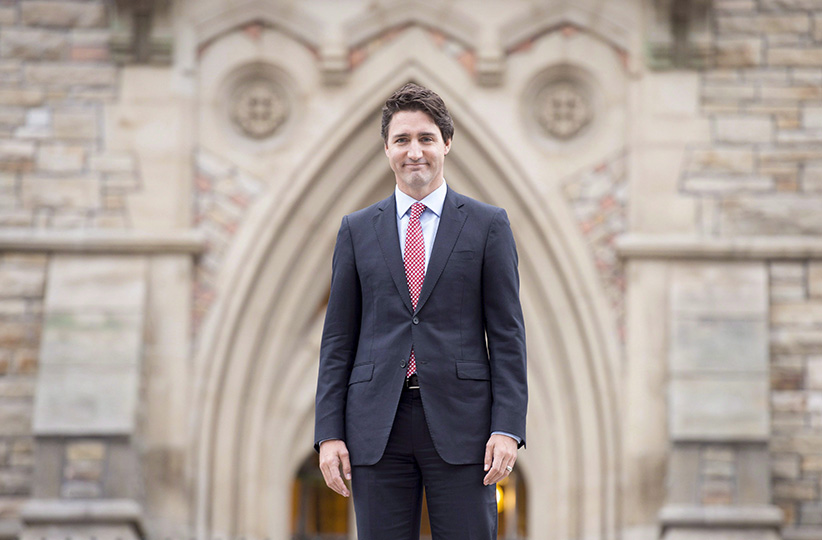Justin Trudeau’s fall agenda: Big files and economic worries
Sure there’s climate change, a health deal, First Nations issues—but don’t forget trade, innovation and infrastructure
Macleans Magazine’s Ottawa and Montreal bureau head shots at Third Floor York studio in Ottawa December 12, 2013.
Photo by Blair Gable
Share

The fall return of Parliament always puts Ottawa in a back-to-school frame of mind. Like kids tidying the contents of their backpacks, we strive for orderly thinking and a clear setting out of goals. In the case of Justin Trudeau’s government, that’s not easy. This Prime Minister’s viral celebrity tugs us toward talking airily about style rather than concretely about substance. Even when we fix our attention on policy, the sheer range of his government’s ambitious promises makes clarity elusive.
It’s awfully tempting to say that what matters most in Canadian politics this fall is whether or not Trudeau keeps up his attention-grabbing online persona. Or a case could be made for any of several separate policy files as the big one to watch—like delivering a credible climate change policy, or an innovative health care funding deal, or an electoral reform proposal to overhaul the way Canadians vote.
But, important as all these elements are, none captures the way Trudeau has consistently signalled he wants, and ultimately expects, his government to be judged. After all, his campaign platform last year was called A New Plan for a Strong Middle Class. And last spring, when he held a news conference before Parliament’s summer break, he mainly emphasized not, say, settling Syrian refugees or naming a gender-balanced cabinet, but three steps the Liberals had taken that would matter to the finances of families: a new child benefit, a middle-income tax cut, and Canada Pension Plan reform.
If we accept his message that middle-class economic well-being is the central goal of the Trudeau government, a tight cluster of files—and not the highest-profile ones—takes on greater importance for the fall. The underlying challenge is huge. Trudeau and his inner circle ran on the premise that Stephen Harper’s Conservatives had failed dismally in delivering economic growth. They also argued that the middle class has been denied its fair share of new national wealth back to the 1970s.
Yet the prospects for palpably stronger economic expansion emerging again anytime soon look poor (as our Jason Kirby explains here). Just last week Bank of Canada senior deputy governor Carolyn Wilkins delivered a sobering speech in London on how governments around the world must face the prospect of slower growth. Wilkins pointed to deep, intractable forces, like aging populations and sluggish advances in productivity, for which there are no easy answers. What, if anything, can the Trudeau Liberals hope to do to lean hard against such global forces?
Not nothing. This fall, three policy thrusts are worth watching. The first is for freer trade, a perennial favourite of economists. Trade Minister Chrystia Freeland is off to Europe this week to try to shore up support for the painstakingly negotiated Canada-European Union trade deal. She’ll be pleading with, among others, German centre-left politicians and EU trade ministers. The Canadian government hopes to finally get the agreement signed at a Canada-EU summit near the end of October. It will be a serious blow for Trudeau if anti-free-trade forces in Europe stymie the deal.
The second economic file to track can be loosely called “innovation.” Back in June, Innovation Minister Navdeep Bains—a key Trudeau political lieutenant in Toronto, but a low-profile minister so far—launched consultations (hallmark of the new Liberal way) into goals like “competing in a digital world” and “building world-leading clusters.” Bains needs to soon prove that this isn’t empty talk by proposing real policy. Meanwhile, Trudeau’s so-called Growth Council, headed by the urbane business consultant Dominic Barton, is supposed to deliver sage policy advice sometime in December.
Barton is bound to tout far-sighted infrastructure spending, which vies with strategic education spending as the most well-worn tool in any competitiveness sage’s kit. This brings us to the third federal economic file to watch. Heard much about Infrastructure Minister Amarjeet Sohi? Nobody else has either. But Sohi presides over $60 billion in new infrastructure money the Liberals have promised to dole out.
So far, only the drab first phase of this huge initiative—spending on maintenance and improvements to existing transit and water systems—has been under way. But Sohi is now working out the high-stakes terms for allocating nearly $50 billion in the second phase—money for more ambitious, more ribbon-cutting-worthy projects. He will announce the rules for how Ottawa will manage this enormous pool of capital in the coming months.
Paying heed to trade, innovation and infrastructure doesn’t mean stinting the autumn priorities that have been grabbing much more attention. Health Minister Jane Philpott and Finance Minister Bill Morneau must come to terms with the provinces on a multi-year health accord. Environment Minister Catherine McKenna must show serious progress by the time she meets her provincial counterparts in early October on pricing carbon as a path to cutting greenhouse gas emissions. Indigenous Affairs Minister Carolyn Bennett needs to back up last spring’s budget promise of billions more for First Nations with practical steps for quickly improving on-reserve water, housing and education.
Visible failure on any of these files would scuff up Trudeau’s high-gloss veneer. But only failure to deliver a broadly shared sense that the economy is being steered in the right direction—”growth for the middle class”—would cut dangerously deeper. From Trudeau’s early days as Liberal leader in opposition, his inner circle has circled back reliably to that core mission.
They argue that while his political appeal is unique, and his government’s diverse aims distinctively responsive to the times, his economic playbook would feel familiar to veterans of, say, the Bill Clinton or Jean Chrétien eras. And the lesson of those recent case studies is that centre-left parties in power thrive, surviving episodic failures, as long as their reputations for delivering prosperity remain intact.